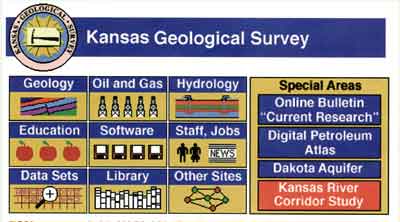by Lee C. Gerhard,
Director and State Geologist

As we reflect on the inherent conflicts between urbanization, recreation, and resource access, the long-term consequences of these issues must be carefully evaluated
As
society places more and more emphasis upon recreation for a growing population,
a consequent stress on natural resources develops. Limestone quarries,
sand and gravel deposits, clays, and other materials that have a low unit
value, but a high “place” value, are frequently overstepped
by urban expansion. It is important that Kansas and its communities identify
the raw materials necessary for future growth and arrange to protect access
to those resources.
The Kansas River corridor supports an estimated 1,000,000 Kansans. This
area is one of the fastest growing in the country and requires an ever-increasing
abundance of basic resources for its continued development. At the same
time, this growing, urban population demands more recreational resources.
As we reflect on the inherent conflicts between urbanization, recreation,
and resource access, the long-term consequences of these issues must be
carefully evaluated.
Similarly, ground water is being “mined” in western Kansas
at a rate that exceeds its natural replenishment. Some have suggested
that our approach to resource conservation has not been holistic, and
that we need to look at the entire natural system to understand the effects
of any perturbation. A new Survey circular on sustainable development
of water resources is thought provoking and should provide the substance
of much debate on resource sustainability.
When I was younger, I had easy answers to some of these questions. I find the answers more difficult now. If you have suggestions that might help Kansans resolve some of these significant questions, I invite you to share them. Comments can be sent to me at lgerhard@kgs.ku.edu.

Oil and gas data, water data, and
a variety of other data sets are now available electronically through
the Kansas Geological Survey’s home page on the World Wide Web.
New data bases, such as a listing of water-well completions in Kansas,
have been posted during the past year; existing data bases are updated
regularly. As a result, the public has access to the same, up-to-date
data bases used by Survey researchers.
The most popular data base is the Survey’s Digital Petroleum Atlas.
That electronic atlas includes oil and gas production data by field (a
data base that was viewed more than 5,000 times by KGS customers during
December 1997), current oil and gas plays, geophysical data, and a variety
of maps for selected Kansas counties and other areas in the northern midcontinent.
Other data sets include a list of well logs in the Survey’s Geoscience
Data Library, an index of holdings in the Survey’s core facility,
plugged wells in the state, and the bibliography of Kansas geology.
The address for the Survey’s home page is www.kgs.ku.edu. To reach the KGS data bases, click on the data sets button on the Survey’s home page.

Online February 10, 2002
Comments to: lbrosius@kgs.ku.edu
Kansas Geological Survey
URL:http://www.kgs.ku.edu/Publications/GeoRecord/1998/vol4.1/Page2.html